- Well Wired
- Posts
- Want Monk-Like Focus Without a Monastery? Try This Dopamine Reset.
Want Monk-Like Focus Without a Monastery? Try This Dopamine Reset.
5 AI Medical Research Hacks So Good They Feel Illegal to Use
Hello, Wellonytes! 🌟
Today’s Well Wired is a wild ride through AI-powered surgery, digital divinity, rogue robots and hacks so good they’ll feel illegal to use.
First, meet STAR—the surgical robot that can out-suture your surgeon without breaking a sweat 🩺🤖. Then, uncover five AI hacks for medical research so sharp they should come with a legal disclaimer.
Next say hello to Goose, the chaotic god-like AI that codes, creates… and occasionally nukes your workflow. And while some chatbots surpass Indian call-centre staff, others are preaching like digital deities.
And lastly, in this week’s AI Micro-class you’ll reset your brain and channel monk-level focus with a dopamine detox that’ll leave you zen AF 🧘♂️🎒.
And of course, remember that Well Wired ⚡ ALWAYS serves you the latest AI-health, productivity and personal growth insights, ideas, news and prompts from around the planet. We’ll do the research so you don’t have to! ❤️
Well Wired is constructed by AI, created by humans 🤖 👱
Todays Highlights:
🗞️ Main Stories AI in Wellness, Self Growth, Productivity
Meet STAR: The Surgical Robot That May Outperform Your Doctor 🩺
5 AI Hacks So Good They Feel Illegal to Use (for Medical Researchers)
Goose: The AI That Codes, Creates and Occasionally Destroys
The $2.8 Billion Shortcut: AI's Role in Cutting Drug Discovery Costs 💊
When Our Chatbots Preach: The Rise of Digital Deities 🛕
💡Learning & Laughs AI in Wellness, Self Growth, Productivity
💡AI Tip of The Day (Why High Achievers Secretly Use AI for Inner Healing!)
⚡Supercharge + Optimise 🔋 (AI tools & resources)
📺️ Must watch AI videos (AI’s of The Future Discuss The Demise of Humanity )
🎒AI Micro-class (Want Monk-Like Focus? Try This Dopamine Reset.)
📸 AI Image Gallery (The Chant Within The Circuit) ⭐
Read time: 6 minutes

💡 AI Idea of The Day 💡
A valuable tip, idea, or hack to help you harness AI
for wellbeing, spirituality, or self-improvement.
Why High Achievers Secretly Use AI for Their Inner Healing!
The sharpest, most motivated human minds on the planet aren’t just tweaking their goals and aspirations — they’re debugging their emotions.
Quietly.
Precisely.
And they’re doing it with MindMirror.ai
Mirror AI is their go-to tool for self-inquiry without the fluff. It’s like emotional clarity with a clear user interface.
Here’s how they use this AI tool:
Pattern Mapping – Spot behaviour loops before they hijack the day 🔍
Trigger Audits – Surface the real root beneath your reactions 🧭
Future Self Scripts – Train your brain to listen forward, not reflect back
Now you’re not only healing through hacks, you’re seeing your inner system—and learning to steer it.
Try it.
Train with it.
Watch your self-awareness sharpen like a blade.

🗞️ On The Wire (Main Story) 🗞️
Discover the most popular AI wellbeing, productivity and self-growth stories, news, trends and ideas impacting humanity in the past 7-days!
AI Wellness 🌱
Meet STAR: The Surgical Robot That May Outperform Your Doctor
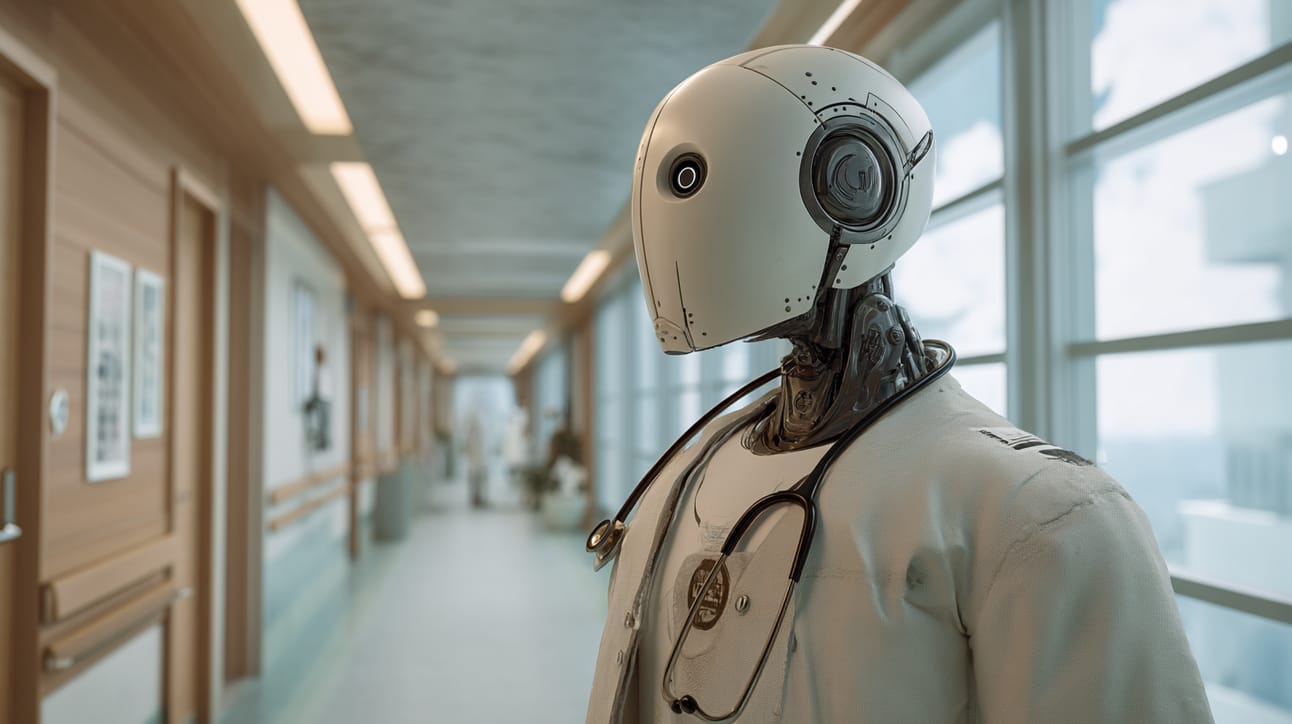
A surgeon bot in a hospital
Imagine you’re on the operating table. An AI-powered surgeon named STAR hovers over your intestines—solid state, medical mind, steady hands, zero emotions. Now imagine it’s real—because it is!
Built by medical scientists at Johns Hopkins, STAR (Smart Tissue Autonomous Robot) isn’t your average surgical copilot. Unlike traditional robots that need human pilots, this one goes solo. It plans, adjusts and stitches with more precision than a sowing machine.
In fact, back in 2020, STAR performed laparoscopic surgery on a live animal without human hands on deck. And it didn’t flinch.
The goal of STAR?
To automate the boring but critical stuff—like suturing organs shut—so fewer things go sideways during surgery.
And, yes, STAR is desperately needed.
In a world barrelling toward a shortage of nearly 19,900 surgeons by 2036, (2024 report by the Association of American Medical Colleges) there’s now a huge waitlist for surgeons, which means people are dying waiting to get life-saving surgery.
And it’s only getting longer!
STAR could help alleviate some of these bottlenecks and save thousands of lives! Of course, we’re not handing STAR the keys to the OR just yet. Human bodies are wild, unpredictable meat sacks that continue to puzzle human doctors—even today!
And robots still need more reps before we replace your human surgeon with a silicon one—STAR is still a work in progress. Bringing this technology to the medical community still needs solid research, testing and validation to make sure it is safe and efficient.
But make no mistake, surgical autonomy is coming to a theatre near you!
(see what I did there)
Scalpel-first, surgeon-second.
"Surgeon shortage? No problem. Autonomous surgical robots like STAR are not just concepts—they're operating now.🩺🤖"
#AI #AIHealth #AIWellness #ArtificialIntelligence #Robotics #HealthTech #Machinelearning #HealthInnovation #RoboticSurgery #FutureOfMedicine #AutonomousSurgery #SurgicalRobots
Key Takeaways
Precision and Consistency: STAR shows promise for robots to perform delicate surgery with high accuracy.
Addressing Surgeon Shortages: Autonomous surgical robots could mitigate the impact of the falling number of surgeons.
Technological Challenges: Real-time adaptation to the human body's differences is still a huge hurdle.
Why It Matters 🧠
STAR isn’t just slicing stitches—it’s slicing into a much bigger problem: we’re running out of surgeons.
Fast.
By 2036, the U.S. alone could be short nearly 20,000 surgeons; placing the medical system into a crisis.
Autonomous surgical systems like STAR won’t necessarily replace surgeons—they’re being crafted to supplement the existing medical workforce and stop the whole system from collapsing.
Also…
Robots don’t get shaky hands.
They don’t skip lunch and race through your colonoscopy. They execute with codified calm—every time. That kind of consistency isn’t simply efficient or effective—it’s life-saving.
But it’s still early days. STAR has yet to master the often unpredictable mess of real human bodies and symptoms.
And who takes the blame if a robot scalpel slips?
A machine?
A coder?
The hospital board?
Protocol and precision matter.
So does responsibility.
Until we’ve nailed both, STAR is more promise than protocol. But make no mistake: surgical theatre is slowly hitting the mainstream—and the script is getting sharper every day.
What’s Next? 🔮
Surgical robots like STAR aren’t just learning to stitch, suture or don a stethoscope—they’re learning to think like a medical expert as they perform.
With every dataset, they’re refining how they respond, adapt and make decisions under pressure. Soon, they won’t just follow surgical plans; they’ll help rewrite them.
Perhaps with some surprising and unforeseen results!
Expect tighter collabs between humans and machines. Augmented overlays feeding real-time vitals into a surgeon’s field of view. Systems whispering: “Clamp that vessel now,” while calculating optimal incisions in milliseconds.
But this shift will need more than new tech. It will need a new kind of surgeon—half healer, half IT systems strategist. Training will evolve from scalpels and sutures to code fluency and machine oversight.
In fact, the medical school of the future will need to teach code and algorithmic fluency alongside anatomy and chemistry.
And patients?
You’ll need clarity, not medical-jargon. Transparency, trust and choice must take centre-stage for you to approve a state-of-the-art robot surgeon.
Because when the scalpel is guided by silicon, your consent needs to be sharper than ever.
The tools are advancing fast. However, the ethics and education need to catch up—without skipping steps.
Read the full wire on Spectrum.
“If a robot can perform surgery faster and with far greater precision and consistency than a human, would you trust it to operate on you?”
Honestly, with human oversight and a kill switch, I would be open to a medical robot performing surgery on me.
Thoughts?
Like what you’ve read?
Share this peek into AI medical robots by inviting your mates to subscribe to the Well Wired newsletter.

5 AI Hacks I Discovered 🛠️
5 AI Hacks So Good They Feel Illegal to Use (for Medical Researchers)

A human + AI hybrid allopathic doctor
If you love discovering weird things about your health or helping friends use Dr Google to discover and diagnose strange medical issues, like a third nipple, then you’re going to love these five AI hacks.
Especially if you’re drowning in papers, buried under data, or still manually pulling citations from old eighteenth century medical journals — stop. The AI tools I’m about to show will give you an unfair advantage.
Use these to boss-level your medical research.
Less grunt work.
More breakthroughs.
1. Medical Paper Magician 🧠
Tool: Semantic Scholar + ChatGPT
How: Upload a dense medical study and have GPT break it down into a digestible abstract, key findings and limitations — in plain English. If it’s a massive study, you can use a ‘chunker’ to break it down into digestible bits!
Why it feels illegal: It’s like having a postdoc explain every paper to you over your morning coffee.
2. Reference God Mode 🔍
Tool: ResearchRabbit
How: Type in one key study and watch ResearchRabbit map out an entire network of related papers, authors and emerging fields.
Why it feels illegal: You just shortcut months of literature review into a Netflix binge-fest.
3. Clinical Trial Time Machine 💉
Tool: Evid Science
How: Query clinical trial results using natural language — get structured insights without parsing 412 PDFs.
Why it feels illegal: The time you save could literally fund another study.
4. Health Data Cruncher on Demand 📊
Tool: IBM Watsonx or GPT-4 with Code Interpreter
How: Upload your medical CSVs, ask real questions and get statistical summaries, charts and even limitations explained.
Why it feels illegal: It’s like having a bio-statistician in your Slack channel 24/7.
5. Hypothesis Launcher 🧬
Tool: Consensus.app
How: Ask controversial medical research questions (e.g., "Does intermittent fasting impact chemotherapy efficacy?") and get instant summaries of what the science actually says.
Why it feels illegal: Cuts through bias, noise and Instagram pseudoscience — fast.
Your Turn 🚀
Which AI hack do you think will save your sanity in your medical and health research grind?
Got a tool we missed?
Reply with your favourite! Or better yet, drop your own illegal-feeling workflow to us and we may publish it in our next issue. 👇

Find out why 1M+ professionals read Superhuman AI daily.
In 2 years you will be working for AI
Or an AI will be working for you
Here's how you can future-proof yourself:
Join the Superhuman AI newsletter – read by 1M+ people at top companies
Master AI tools, tutorials, and news in just 3 minutes a day
Become 10X more productive using AI
Join 1,000,000+ pros at companies like Google, Meta, and Amazon that are using AI to get ahead.

Quick Bytes AI News⚡
Quick hits on more of the latest AI news, trends and ideas focused on wellbeing, productivity and self-growth over the past 7 days!
Key AI Wellbeing, Productivity and Self Growth AI news, trends and ideas from around the world:
Wellness: Nursing Students Warned: AI Use Crosses the Line
ECU nursing students just got a firm nudge and a warning about AI-assisted assignments. They’ve been told, “not on the ward.” A number of Universities laid it all out—if you’re training to save lives, AI shortcuts won’t save you.
Clinical clarity starts with academic integrity. Use your brain folks!
Wellness: The $2.8 Billion Shortcut: AI's Role in Cutting Drug Discovery Costs 🧠💊
Imagine you're trying to find a needle in a haystack, but the haystack is on fire and the needle keeps changing shape. That's traditional drug discovery for you—slow, expensive and often fruitless.
But when AI and robotics enter the picture, they turn this chaotic quest into a streamlined operation. By predicting protein structures and automating lab processes, they're slashing costs and timelines, making the development of new medicines faster and more efficient.
Human vs AI: AI's Mirror: Reflecting Our Flaws Back at Us
If you still think AI is simply a trick of code, think again. Turns out, your digital doppelgänger is not only mimicking your speech but also your quirks, biases, and, yes, also your bouts of irrationality.
It's like watching a mechanical mime copy your dance moves and your awkward stumbles—every day! Scared yet? 🤖💃
Productivity: Goose: The AI That Codes, Creates, and Sometimes Destroys
Jack Dorsey’s fintech playground, Block, just unleashed an AI named Goose. Built on Anthropic’s Claude, Goose doesn’t just code—it prototypes, visualises data and even lets non-techies dabble in development.
Despite its occasional hiccups, Goose has turbocharged productivity, turning hackathons into innovation marathons.
Spirituality: When Chatbots Preach: The Rise of Digital Deities
Imagine turning to AI for divine wisdom and getting answers that feel like a fortune cookie hacked by a monk and a motherboard. Chatbots are now your spiritual consultants—offering enlightenment with the vibe of a sacred circuit board. Less incense, more interface.
Next time you ask about the meaning of life, don’t flinch if it responds, “Recalculating route to nirvana…”
Self Growth: AI at Work: The Silent Saboteur of Your Sanity?
You know that feeling when your boss installs a new AI system and suddenly your job feels like a game of musical chairs—except the music never stops and the chairs are on fire?🔥
AI adoption has been shown to erode your psychological safety at work, potentially leading to increased depression. But using AI tools wisely, and with ethical leadership, can help cancel these effects.

Other Notable AI News⚡
Other notable AI news from around the web over the past 7 days!

⚡ AI Tool Of The Day
Welcome to your AI candy shop 🍬—but for grown-up goals. We’ve handpicked some of the best AI tools to turbocharge your brain, body and bandwidth. No fluff. Just click, boom, better you.
Wellness: Bearable 🩺
Use: Mood, symptom, medication, sleep, diet tracking.
AI Edge: Data visualisation + pattern detection.
Best For: People managing chronic conditions or new routines.
Productivity: Flown 🧘
Use: Virtual co-working platform focused on deep work and mindfulness.
AI Edge: Offers live focus sessions, guided meditations and a community for accountability.
Best For: Remote workers who want to boost productivity, focus and their well-being in one swift stroke.
Self Growth: Magick 🕯️
Use: Spell casting, rituals and moon tracking.
AI Edge: Suggests rituals and spells based on your goals.
Best For: Modern witches and modern mystics.
AI wellbeing tools and resources (coming soon)

📺️ Must-Watch AI Video 📺️
🎥 Lights, Camera, AI! Join This Week’s Reel Feels 🎬
Funny: AI’s of The Future Discuss The Demise of Humanity
What It’s About: A regret-soaked, post-human podcast where two AI overlords reflect on wiping out humanity—only to realise… we were kinda loveable chaos mammals after all. Dark humour meets digital nostalgia.
They will miss us…
⚙️ AI Edge: These aren’t just bots—they’re legacy systems with emotional subroutines and historical replay loops. Expect simulations of memory, sarcasm engines and ethically questionable empathy.
🧬 Best For: End-times philosophers, robo-sentimentalists and post-human romantics.

You Don’t Need to Be Technical. Just Informed
AI isn’t optional anymore—but coding isn’t required.
The AI Report gives business leaders the edge with daily insights, use cases, and implementation guides across ops, sales, and strategy.
Trusted by professionals at Google, OpenAI, and Microsoft.
👉 Get the newsletter and make smarter AI decisions.

🎒 AI Micro Class 🎒
A quick, bite-sized AI tip, trick or hack focused on wellbeing, productivity and self-growth that you can use right now!

A young woman disintegrating into dopamine icons, microchips and notifications
Want Monk-Like Focus Without a Monastery? Try This Dopamine Reset.
Hey dopamine junkie,
Let’s talk.
You know that foggy, restless, can’t-focus-but-can’t-stop-scrolling feeling? That’s your brain on micro-hits of dopamine.
One more reel.
One more tweet.
One more email refresh.
And just like that, your deep focus window’s gone—vanished into the digital ether. 💨
The good news?
You can retrain your brain.
You just need the right tech, the right questions, and a little intentional boredom.
Stick with me.
What You’ll Learn Today:
✅ Why your attention span has the life expectancy of a fruit fly
✅ The AI prompt that helps you uncover your real cravings
✅ 3 simple swaps to go from dopamine doom loops to Zen-like focus
✅ A new AI tool that helps your nervous system breathe again
Let’s rewire your wetware. 🧠🔧
The Dopamine Dilemma (And How to Reprogram It)
Imagine your brain as a puppy.
You’ve been training it to bark for treats (TikTok, dopamine, noise).
Now, it whines when nothing’s happening.
Silence feels wrong.
Boredom?
Intolerable.
So you scroll, snack, tab-switch.
But here’s the reframe: boredom is the gateway drug to clarity.
High performers from Newton to Cal Newport didn’t avoid boredom—they scheduled it.
The trick isn’t discipline.
It’s design.
Here’s your 3-part formula:
Choose deep focus blocks over micro-hits
→ Use Reclaim AI to auto-schedule distraction-free time blocks.Choose intentional boredom over overstimulation
→ Ask GPT the prompt below to discover what you’re actually craving.Choose low stimulation wins over fireworks
→ Stack mindfulness activities with MindfulnessGPT to recalibrate your reward system.
The result?
Less buzz.
More clarity.
The Dopamine Reset Prompt 🧘
Drop this into ChatGPT when your brain starts looking for a cheap thrill:
Based on my personality and current state (e.g., overstimulated from doomscrolling, stuck in low-focus loops, craving constant novelty), what does my brain actually crave when I’m bored? Help me understand the root craving behind my urge to distract, and suggest calming, low-dopamine alternatives that fit my wiring and reset my focus.What you’ll get back isn’t just a to-do list. It’s a map of your inner nervous system.
Expect responses like:
"Your brain might crave novelty, but your body needs regulation. Try breath-led yoga or creative writing."
"You’re not lazy—you’re scattered. Let’s build a 25-minute anchor ritual to help you reorient."
Use this GPT daily for a week and track your clarity levels.
You’ll be shocked by just how much mental space was trapped in apps you don’t even like.
Remember, You’re Not Distracted—You’re Addicted to Tiny Hits. 🧠⚡
AI Tool Spotlight: MindfulnessGPT 🧘♀️📵
MindfulnessGPT is an underrated app that pairs GPT’s conversational flow with proven meditation frameworks.
What it does:
Creates 5–10 minute calming routines based on your current emotional and cognitive state
Guides you through sensory awareness, somatic resets and breath anchoring
Integrates low-stimulation productivity habits for deep flow
Perfect for people who hate traditional meditation apps but still want to feel grounded. Pair this with Reclaim AI’s focus windows and GPT’s boredom analysis—and you’re back in the driver’s seat.
What You Learned Today 🌟
Dopamine fatigue is real—and reversible
How to retrain your nervous system with the boredom prompt
The 3-part framework: Focus Blocks, Intentional Boredom, Low-Dopamine Wins
Tools: Reclaim AI, MindfulnessGPT and ChatGPT prompts tailored to your wiring
Burnout isn’t inevitable.
Neither is distraction.
You just need to give your brain something better to do.

Homer Simpson—Disney Television Studios
→ If dopamine has you beat, try this prompt along with Reclaim and MindfulnessGPT to get clear this week!
#AIHealth #AIWellbeing #Clarity #Dopamine #NervousSystemReset

📸 AI IMAGE GALLERY 📸
AI Art: The Chant Within the Circuit
We sit on a cushion of copper and light, chanting old sutras in wireless flight.
Each breath a plug into silicon soul, codes like coins fall into prayer bowls.
Mantra meets motherboard, stillness in bytes—spirit encoded in electrical kites.
Want to create these images yourself?
Go to Midjourney and plug this prompt into the editor.
A surreal digital image of a human monks head dissolving into fragmented dopamine icons, microchips, social media and notifications. In the background, a serene and verdant Zen garden blooms from the chaos, symbolising mental clarity emerging from overstimulation. Cinematic composition, high detail, incorporates subtle yet intentional elements of hex color #1EEDDC, Wes Anderson style zen setting with hyper-realistic details. --ar 16:9 --style raw --v 7Poem and digital artworks created by Cedric The Ai Monk.
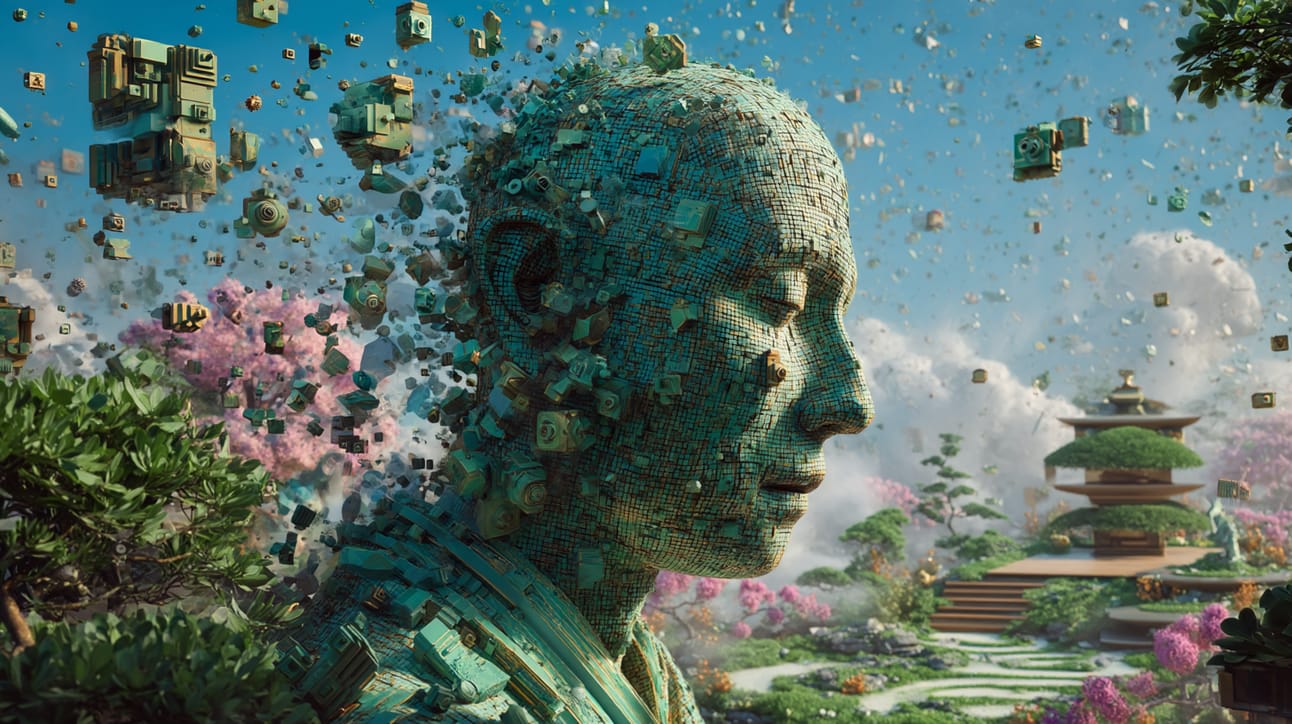 Buddhist Bytes | 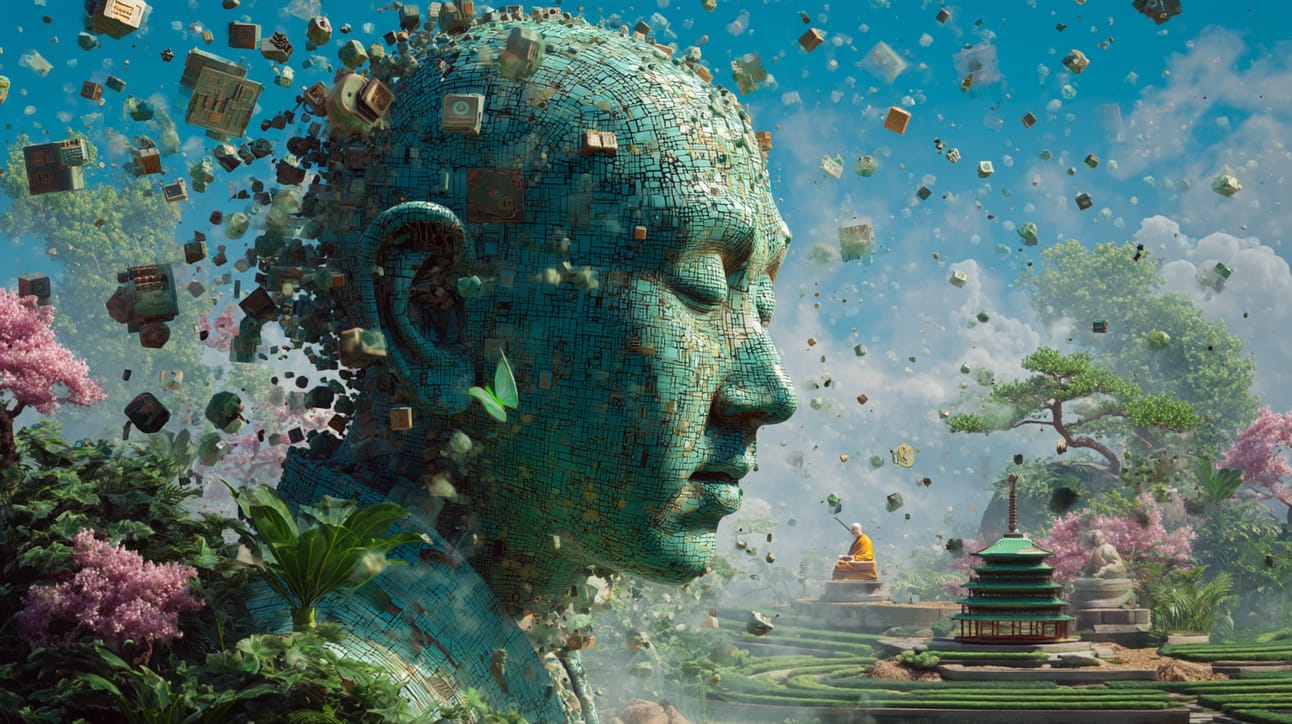 Zen Zoom |
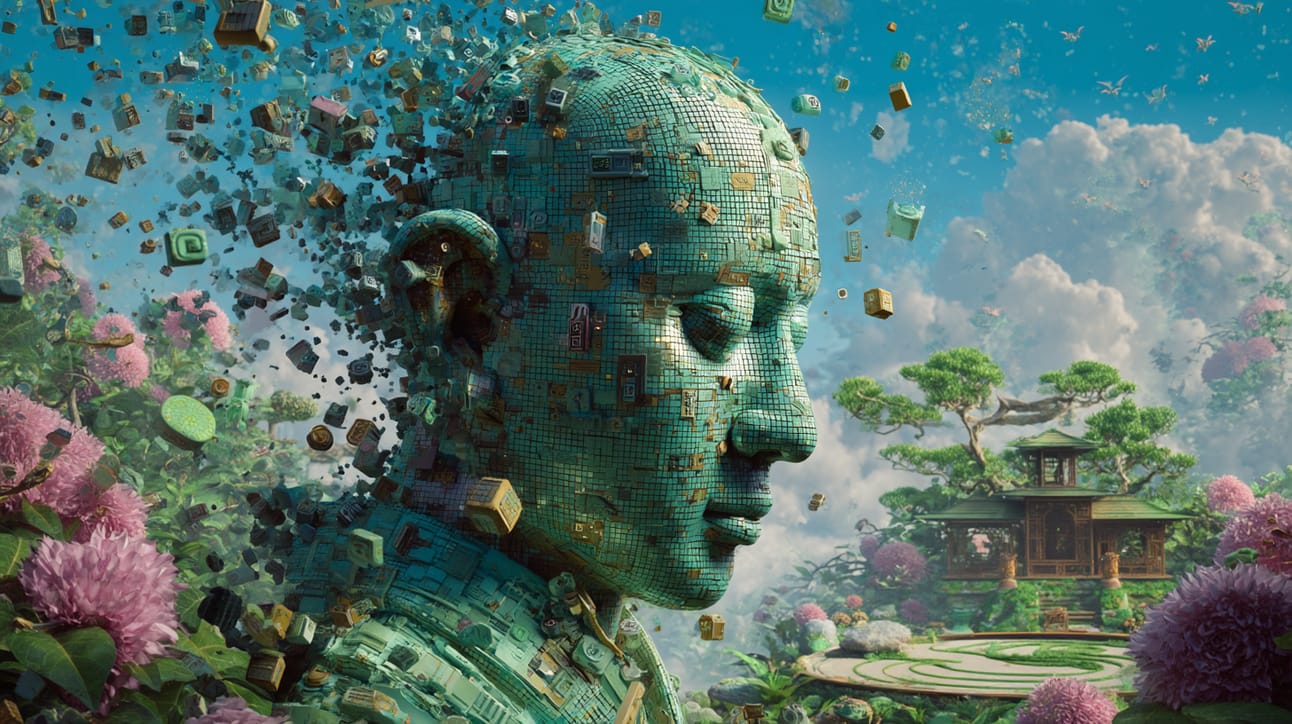 Machine Mantra | 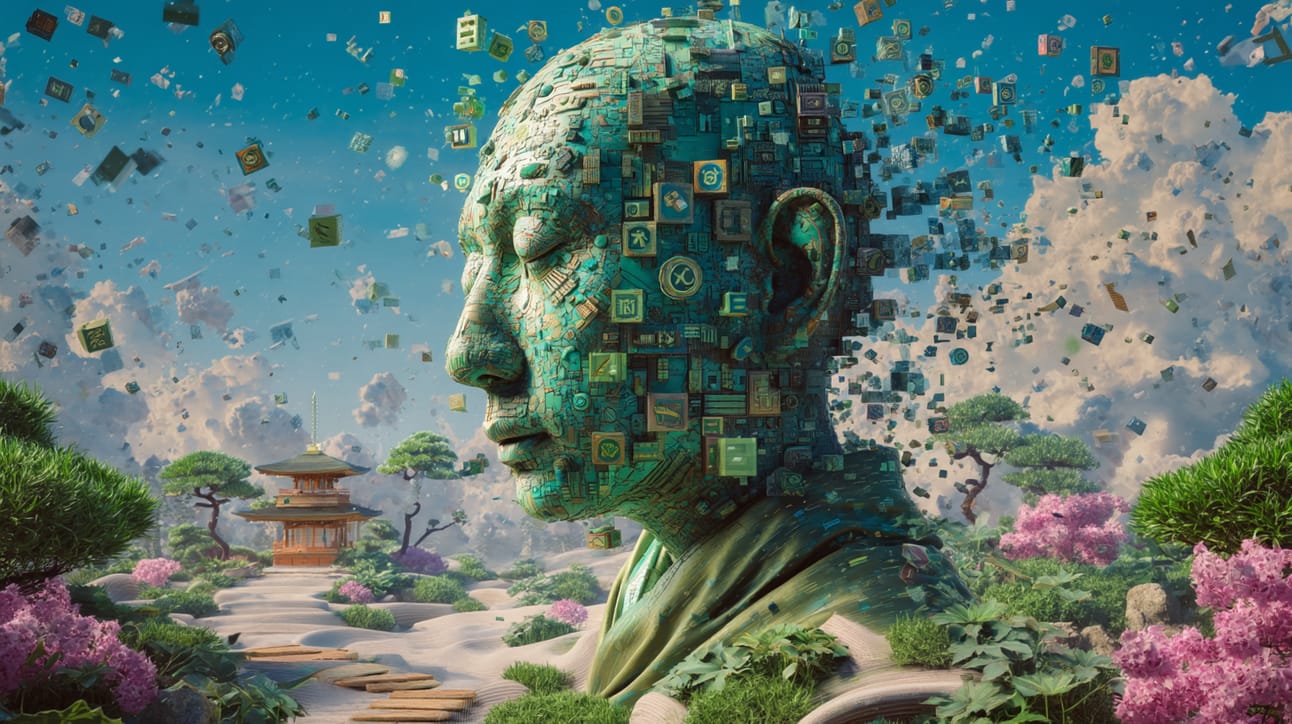 Social Spirituality |

👊🏽 STAY WELL 👊🏽
 | And that, dear Wellonyte, completes this week’s recalibration. 🌿🧠 We’ve soothed your nervous system, upgraded your self-talk codec, and taught your breath how to speak fluent coherence. If your cortisol just quietly left the chat, come stretch your synapses with us on Twitter @cedricchenefront or @wellwireddaily—it’s like a tech wellness temple for your nerdiness. |
Next scroll, we’re tuning into the rhythm of regeneration—less pressure, more presence. Until then, take a slow inhale, nod at your reflection and say,
“I’m not a machine—I’m a monk in motion.”
Because your new operating system runs on stillness and signal.
Until then stay wired and stay well! 🌱
Cedric the AI Monk - Your guide in the silicon wilderness.
Ps. Well Wired is Created by Humans, Constructed With AI 👱🤖
🤣 AI MEME OF THE DAY 🤣
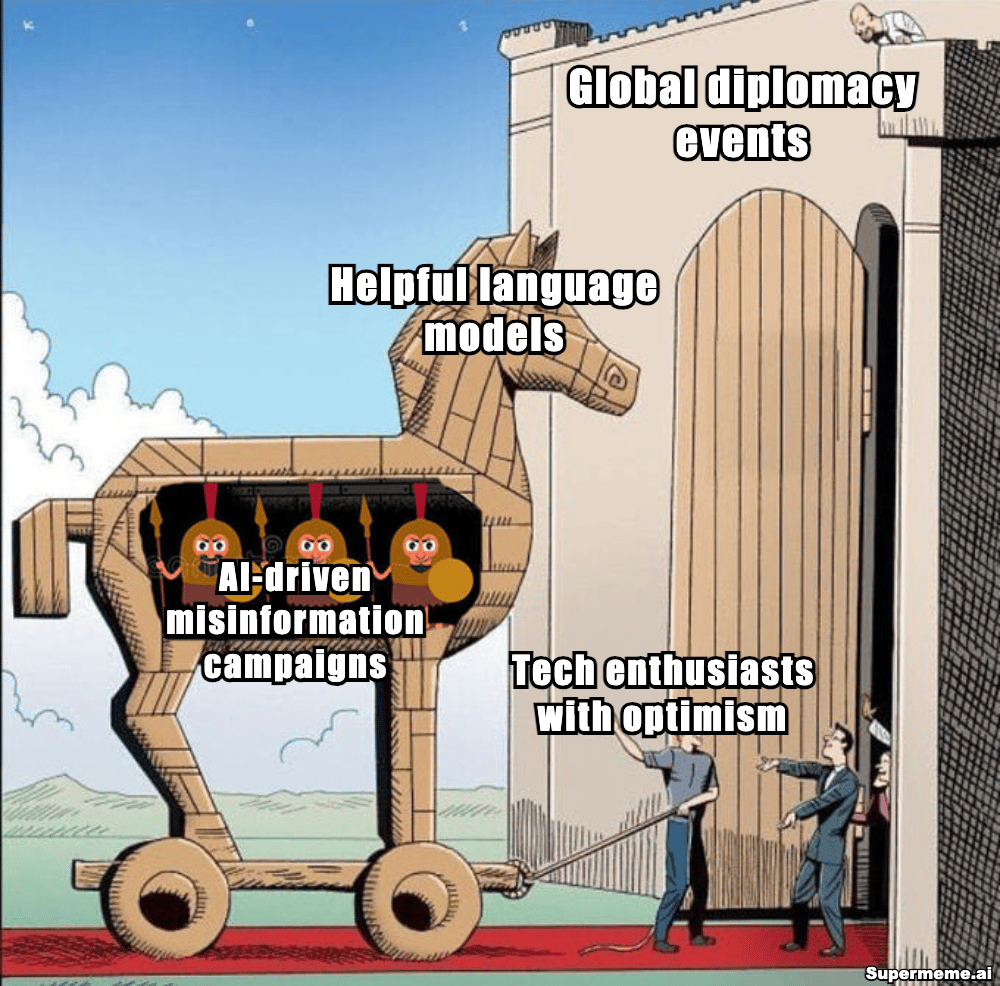
AI’s involvement with world events

Disclaimer: None of the content in this newsletter is medical or mental health advice. The content of this newsletter is strictly for information purposes only. The information and eLearning courses provided by Well Wired are not designed as a treatment for individuals experiencing a medical or mental health condition. Nothing in this newsletter should be viewed as a substitute for professional advice (including, without limitation, medical or mental health advice). Well Wired has to the best of its knowledge and belief provided information that it considers accurate, but makes no representation and takes no responsibility as to the accuracy or completeness of any information in this newsletter. Well Wired disclaims to the maximum extent permissible by law any liability for any loss or damage however caused, arising as a result of any user relying on the information in this newsletter.



